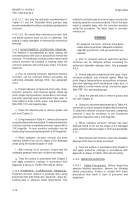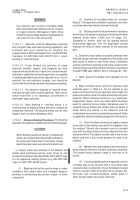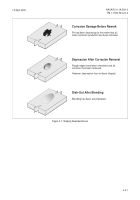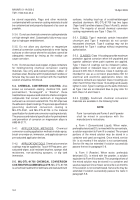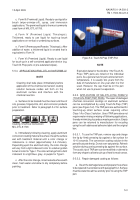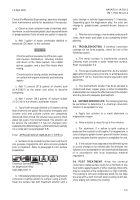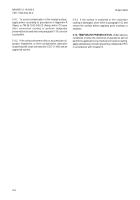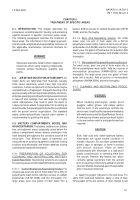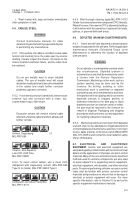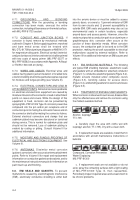TM-1-1500-344-23-2 - Page 100 of 240
5-2
NAVAIR 01-1A-509-2
TM 1-1500-344-23-2
15 April 2009
be stored separately. Rags and other materials
contaminated with conversion coating materials should
be containerized and properly disposed of as soon as
possible.
5-3.4. Do not use chemical conversion coating materials
on high-strength steel. Catastrophic failure may occur
due to hydrogen embrittlement.
5-3.5. Do not allow any aluminum or magnesium
chemical conversion coating materials to enter faying
surfaces or other areas where the solutions cannot be
adequately removed by rinsing as the residue can
cause corrosion.
5-3.6. Do not use steel, lead, copper, or glass containers
for holding/storing chemical conversion coating
materials. Use only acid-resistant plastic, rubber, or
stainless steel. Brushes with tin plated steel handles or
ferrules may be used, but contact with the treatment
solution should be minimized.
5-4. CHEMICAL CONVERSION COATING
. Also
known as conversion coating, chemical film, paint
pretreatment, "Accelagold", or "Alodine", these
treatments are aqueous acid solutions of active inorganic
compounds that convert aluminum or magnesium
surfaces to a corrosion resistant film. This film improves
the adhesion of paint coatings. The process specification
governing aluminum conversion coating is
MIL-DTL-5541, and MIL-DTL-81706 is the material
specification for aluminum conversion coating materials.
The process and material specification for pretreatment
and prevention of corrosion on magnesium alloys is
AMS-M-3171.
5-4.1.
APPLICATION METHODS. Chemical
conversion coating application methods include spray,
brush-on or wipe-on, immersion, and applicator pens or
pre-saturated applicator devices.
5-4.2.
APPLICATION TOOLS. Chemical conversion
coatings may be applied by Touch-N-Prep pens, pre-
saturated wipes, acid resistant brushes, sponge stick
moisteners, non-atomizing sprayers, or dip tank
immersion.
5-5. MIL-DTL-81706 CHEMICAL CONVERSION
COATING FOR ALUMINUM ALLOYS
. MIL-DTL-81706
is a chemical treatment for both bare and clad aluminum
surfaces, including touch-up of scratched/damaged
anodized aluminum. MIL-DTL-81706 has two types
(Type I and II) and two classes (Class 1A and 3), and six
forms. The majority of aircraft chemical conversion
coating requirements are Type 1 Class 1A.
5-5.1. TYPES. Type I materials contain hexavalent
chromium and Type II materials do not contain
hexavalent chromium. Type II coatings may not be
substituted for Type 1 coatings without engineering
authorization.
5-5.2. CLASSES. Class 1A coatings provide maximum
protection against corrosion when left unpainted and
superior adhesion when paint systems are applied.
Type 1 Class 1A coatings can be iridescent yellow,
golden brown or iridescent blue in color and rarely
exceed 0.005 mils in thickness. Class 3 coatings are
intended for use as a corrosion preventative film for
electrical and electronic applications where low
resistance contacts are required. Class 3 coatings are
often much thinner than Class 1A coatings and usually
lighter in color. Type II coatings are the same thickness
as Type I, but are an iridescent blue to gray color for
both Class 1A and Class 3.
5-5.3. FORMS. Aluminum chemical conversion
materials are available in the following forms:
NOTE
Form I concentrate and Forms II and V powder
shall be mixed in accordance with the
manufacturer’s instructions.
a. Form I (Concentrated Liquid). When water,
preferably deionized (DI), is mixed with the concentrate,
a solution equivalent to Form III is created. The unused
portions of the mixed solution may be stored in a
container and used as required. Once mixed, service
life
is six months if the solution is not contaminated.
Service life may be extended if solution successfully
passes the test in paragraph 5-8.
b. Form II (Powder). When water, preferably
deionized (DI), is mixed with the powder, a solution
equivalent to Form III is created. The unused portions of
the mixed solution may be stored in a container and
used as required. Once mixed, service life is six months
if the solution is not contaminated. Service life may be
extended if solution successfully passes the tests in
paragraph 5-8.
Back to Top





